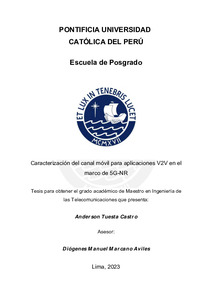| dc.contributor.advisor | Marcano Aviles, Diógenes Manuel | |
| dc.contributor.author | Tuesta Castro, Anderson | |
| dc.date.accessioned | 2024-03-05T20:08:15Z | |
| dc.date.available | 2024-03-05T20:08:15Z | |
| dc.date.created | 2023 | |
| dc.date.issued | 2024-03-05 | |
| dc.identifier.uri | http://hdl.handle.net/20.500.12404/27242 | |
| dc.description.abstract | Las comunicaciones entre vehículos se perfilan a ser ampliamente utilizadas en el
futuro; es por ello que en el presente trabajo se estudió y caracterizó de forma teórica y
mediante simulaciones el canal móvil para aplicaciones V2V. Para lograrlo, se empleó
un modelo de canal multitrayecto variante en el tiempo en el cual las amplitudes de cada
uno de los trayectos existentes fueron representadas con la distribución de probabilidad
de Weibull y su respectivo efecto doppler asociado; asimismo, se modeló la no
estacionariedad en el dominio del tiempo empleando un proceso de prendido y apagado
de cada trayecto en un determinado instante de tiempo usando la distribución de
probabilidad uniforme y se garantizó la correlación de cada uno de ellos empelando un
algoritmo publicado en la literatura existente. Con todo esto, se implementó el modelo
usando Matlab y se validó su correcto funcionamiento realizando simulaciones con datos
reales obtenidos de mediciones. Finalmente, se realizó el análisis de la numerología
para cada escenario simulado, teniendo en cuenta el marco de 5G-NR. | es_ES |
| dc.description.abstract | Vehicle-to-vehicle communications are set to be widely used in the future; that is why
in the present work the mobile channel for V2V applications was studied and
characterized theoretically and through simulations. To achieve this, a time-varying
multipath channel model was used in which the amplitudes of each of the existing paths
were represented with the Weibull probability distribution and its respective associated
Doppler effect; likewise, the non-stationarity in the time domain was modeled using a
process of turning each path on and off at a given instant of time using the uniform
probability distribution and the correlation of each one of them was guaranteed using an
algorithm published in the existing literature. With all this, the model was implemented
using Matlab and its correct functioning was validated by carrying out simulations with
real data obtained from measurements. Finally, the numerology analysis was performed
for each simulated scenario, considering the 5G-NR framework. | es_ES |
| dc.language.iso | spa | es_ES |
| dc.publisher | Pontificia Universidad Católica del Perú | es_ES |
| dc.rights | info:eu-repo/semantics/closedAccess | es_ES |
| dc.subject | Sistemas de comunicación móvil | es_ES |
| dc.subject | Simulación con computadoras | es_ES |
| dc.subject | Algoritmos--Aplicaciones | es_ES |
| dc.title | Caracterización del canal móvil para aplicaciones V2V en el marco de 5G-NR | es_ES |
| dc.type | info:eu-repo/semantics/masterThesis | es_ES |
| thesis.degree.name | Maestro en Ingeniería de las Telecomunicaciones | es_ES |
| thesis.degree.level | Maestría | es_ES |
| thesis.degree.grantor | Pontificia Universidad Católica del Perú. Escuela de Posgrado. | es_ES |
| thesis.degree.discipline | Ingeniería de las Telecomunicaciones | es_ES |
| renati.advisor.cext | 173908772 | |
| renati.advisor.orcid | https://orcid.org/0000-0002-9707-6348 | es_ES |
| renati.advisor.pasaporte | 024783077 | |
| renati.author.dni | 72230780 | |
| renati.discipline | 613097 | es_ES |
| renati.juror | Bartra Gardini, Gumercindo | es_ES |
| renati.juror | Marcano Aviles, Diógenes Manuel | es_ES |
| renati.juror | Velarde Ortiz, Edgar Eduardo | es_ES |
| renati.level | https://purl.org/pe-repo/renati/level#maestro | es_ES |
| renati.type | https://purl.org/pe-repo/renati/type#tesis | es_ES |
| dc.publisher.country | PE | es_ES |
| dc.subject.ocde | https://purl.org/pe-repo/ocde/ford#2.02.05 | es_ES |






